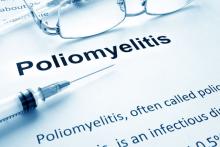Poliovirus vaccinations for children in the United States who may have been vaccinated elsewhere must meet Advisory Committee on Immunization Practices recommendations to ensure protection against all three poliovirus types, according to guidance published in the Centers for Disease Control and Prevention’s Morbidity and Mortality Weekly Report.
Although the United States continues to use an inactivated polio vaccine (IPV) that contains all three types, other countries using an oral polio vaccine (OPV) switched from a trivalent oral poliovirus vaccine (tOPV) to a bivalent version (bOPV) after the World Health Organization declared type 2 polio virus eradicated in September 2015.
“Children living in the United States who might have received poliovirus vaccination outside the United States should meet ACIP recommendations for poliovirus vaccination, which require protection against all three poliovirus types by age-appropriate vaccination with IPV or tOPV,” according to Mona Marin, MD, of the National Center for Immunization and Respiratory Diseases at the Centers for Disease Control and Prevention in Atlanta, and her colleagues.The researchers note that only written, dated records are acceptable evidence of complete vaccination, and documentation of polio vaccination outside of the United States should specify that the child has been vaccinated against all three types. “If both tOPV and IPV were administered as part of a series, the total number of doses needed to complete the series is the same as that recommended for the U.S. IPV schedule,” they wrote. That is, all infants and children should receive four doses of IPV at ages 2 months, 4 months, 6-18 months, and at 4-6 years. The minimum interval between the third and fourth doses should be 6 months.
Children younger than 18 years lacking written, dated documentation of poliovirus vaccination should be vaccinated or revaccinated according to the U.S. IPV schedule for their age, according to the guidelines.
Serologic testing, once used to confirm immunity to polio, is not recommended as a measure of immunity in the United States because antibody testing against type 2 poliovirus often is not available, the researchers added.
The full guidelines are available at MMWR. 2017 Jan 13. doi: 10.15585/mmwr.mm6601a6.


